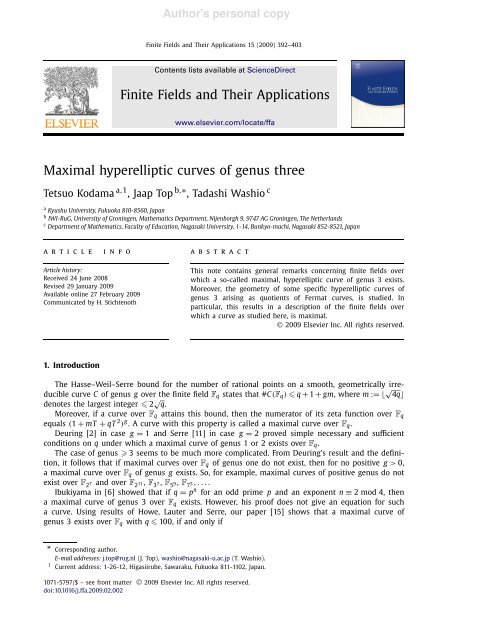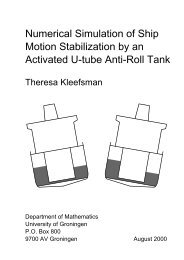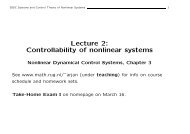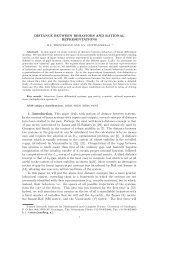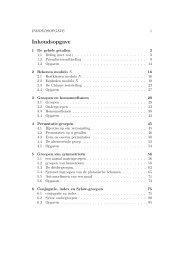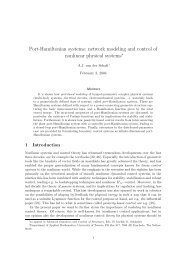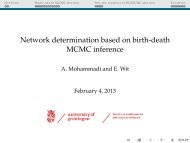Maximal hyperelliptic curves of genus three
Maximal hyperelliptic curves of genus three
Maximal hyperelliptic curves of genus three
Create successful ePaper yourself
Turn your PDF publications into a flip-book with our unique Google optimized e-Paper software.
Author's personal copy<br />
Finite Fields and Their Applications 15 (2009) 392–403<br />
Contents lists available at ScienceDirect<br />
Finite Fields and Their Applications<br />
www.elsevier.com/locate/ffa<br />
<strong>Maximal</strong> <strong>hyperelliptic</strong> <strong>curves</strong> <strong>of</strong> <strong>genus</strong> <strong>three</strong><br />
Tetsuo Kodama a,1 , Jaap Top b,∗ , Tadashi Washio c<br />
a Kyushu University, Fukuoka 8108560, Japan<br />
b IWIRuG, University <strong>of</strong> Groningen, Mathematics Department, Nijenborgh 9, 9747 AG Groningen, The Netherlands<br />
c Department <strong>of</strong> Mathematics, Faculty <strong>of</strong> Education, Nagasaki University, 114, Bunkyomachi, Nagasaki 8528521, Japan<br />
a r t i c l e i n f o a b s t r a c t<br />
Article history:<br />
Received 24 June 2008<br />
Revised 29 January 2009<br />
Available online 27 February 2009<br />
Communicated by H. Stichtenoth<br />
This note contains general remarks concerning finite fields over<br />
which a socalled maximal, <strong>hyperelliptic</strong> curve <strong>of</strong> <strong>genus</strong> 3 exists.<br />
Moreover, the geometry <strong>of</strong> some specific <strong>hyperelliptic</strong> <strong>curves</strong> <strong>of</strong><br />
<strong>genus</strong> 3 arising as quotients <strong>of</strong> Fermat <strong>curves</strong>, is studied. In<br />
particular, this results in a description <strong>of</strong> the finite fields over<br />
which a curve as studied here, is maximal.<br />
© 2009 Elsevier Inc. All rights reserved.<br />
1. Introduction<br />
The Hasse–Weil–Serre bound for the number <strong>of</strong> rational points on a smooth, geometrically irreducible<br />
curve C <strong>of</strong> <strong>genus</strong> g over the finite field F q states that #C(F q ) q + 1 + gm, where m := √ 4q<br />
denotes the largest integer 2 √ q.<br />
Moreover, if a curve over F q attains this bound, then the numerator <strong>of</strong> its zeta function over F q<br />
equals (1 + mT + qT 2 ) g . A curve with this property is called a maximal curve over F q .<br />
Deuring [2] in case g = 1 and Serre [11] in case g = 2 proved simple necessary and sufficient<br />
conditions on q under which a maximal curve <strong>of</strong> <strong>genus</strong> 1 or 2 exists over F q .<br />
The case <strong>of</strong> <strong>genus</strong> 3 seems to be much more complicated. From Deuring’s result and the definition,<br />
it follows that if maximal <strong>curves</strong> over F q <strong>of</strong> <strong>genus</strong> one do not exist, then for no positive g > 0,<br />
a maximal curve over F q <strong>of</strong> <strong>genus</strong> g exists. So, for example, maximal <strong>curves</strong> <strong>of</strong> positive <strong>genus</strong> do not<br />
exist over F 2 7 and over F 2 11 , F 3 7 , F 5 9 , F 7 5, . . . .<br />
Ibukiyama in [6] showed that if q = p n for an odd prime p and an exponent n ≡ 2 mod 4, then<br />
a maximal curve <strong>of</strong> <strong>genus</strong> 3 over F q exists. However, his pro<strong>of</strong> does not give an equation for such<br />
a curve. Using results <strong>of</strong> Howe, Lauter and Serre, our paper [15] shows that a maximal curve <strong>of</strong><br />
<strong>genus</strong> 3 exists over F q with q 100, if and only if<br />
*<br />
Corresponding author.<br />
Email addresses: j.top@rug.nl (J. Top), washio@nagasakiu.ac.jp (T. Washio).<br />
1 Current address: 12612, Higasiirube, Sawaraku, Fukuoka 8111102, Japan.<br />
10715797/$ – see front matter © 2009 Elsevier Inc. All rights reserved.<br />
doi:10.1016/j.ffa.2009.02.002
Author's personal copy<br />
T. Kodama et al. / Finite Fields and Their Applications 15 (2009) 392–403 393<br />
q ∈ {8, 9, 19, 25, 29, 41, 47, 49, 53, 61, 64, 67, 71, 79, 81, 89, 97}.<br />
Moreover, in each <strong>of</strong> these cases an explicit example is given.<br />
Other explicit examples are known by reducing wellknown <strong>curves</strong> <strong>of</strong> <strong>genus</strong> 3 defined over Q.<br />
A famous example is the Klein curve, defined by the equation<br />
x 3 y + y 3 z + z 3 x = 0.<br />
This turns out to be a maximal curve over F q 2 , if and only if the prime power q ≡ 6 mod 7. The<br />
beautiful survey by Elkies [3] does not mention this result which is probably well known; a recent<br />
reference is the PhD thesis [10]. A second wellknown example is given by the Fermat curve with<br />
equation<br />
x 4 + y 4 + z 4 = 0.<br />
This defines a maximal curve over F q 2 , for every prime power q ≡ 3 mod 4.<br />
The literature also contains some maximal <strong>hyperelliptic</strong> <strong>curves</strong> <strong>of</strong> <strong>genus</strong> 3. In the present note<br />
we describe the geometry <strong>of</strong> some <strong>of</strong> these examples, and add some new ones. The new ones are<br />
obtained by taking quotients <strong>of</strong> certain <strong>hyperelliptic</strong> <strong>curves</strong> <strong>of</strong> higher <strong>genus</strong>, following a construction<br />
given in [14, §2]. The idea <strong>of</strong> constructing explicit maximal <strong>curves</strong> as quotients <strong>of</strong> known ones is well<br />
known; for instance, it has been used in the case <strong>of</strong> socalled Hermitian <strong>curves</strong> [1,4].<br />
A <strong>hyperelliptic</strong> curve C over F q has a unique quadratic twist by the <strong>hyperelliptic</strong> involution, which<br />
is denoted C tw . If #C(F q ) = q + 1 − t, then #C tw (F q ) = q + 1 + t. In particular, a maximal <strong>hyperelliptic</strong><br />
curve over F q exists if and only if a minimal <strong>hyperelliptic</strong> curve over F q exists. Here minimal means<br />
that the number <strong>of</strong> rational points equals q + 1 − gm, with notations as before.<br />
Since q + 1 − 3m < 0 for all prime powers q 27 (and also for q = 31), a maximal <strong>hyperelliptic</strong><br />
curve <strong>of</strong> <strong>genus</strong> 3 does not exist over a field <strong>of</strong> cardinality 27 or equal to 31. For q ∈ {29, 32} one<br />
finds q + 1 − 3m = 0, and [5, Thm. 1.3] yields that a <strong>hyperelliptic</strong> curve <strong>of</strong> <strong>genus</strong> 3 without rational<br />
points does not exist over F q for these q. The list given earlier shows that for q = 37 a maximal curve<br />
<strong>of</strong> <strong>genus</strong> 3 does not exist. Moreover, the curve corresponding to y 2 = x 8 + 1 is maximal over F 49 , as<br />
follows from Proposition 2 below. We now consider all prime powers q between 37 and 49.<br />
For q = 47 one finds m = √ 4q = 13 and m 2 − 4q = −19. In this case, a unique maximal curve <strong>of</strong><br />
<strong>genus</strong> 3 over F 47 exists, as is explained in, e.g., [17]. The resulting curve is, however, not <strong>hyperelliptic</strong>.<br />
For q = 43 it follows from [9, Thm. 1] that a maximal curve <strong>of</strong> <strong>genus</strong> 3 does not exist.<br />
The case q = 41 we treated by explicit calculation: inspecting all <strong>hyperelliptic</strong> <strong>curves</strong> <strong>of</strong> <strong>genus</strong> 3<br />
over F 41 , one finds that none <strong>of</strong> them is maximal.<br />
Hence we showed:<br />
Proposition 1. q = 49 is the smallest prime power for which a maximal <strong>hyperelliptic</strong> curve <strong>of</strong> <strong>genus</strong> 3 over F q<br />
exists.<br />
In the remainder <strong>of</strong> this note, pro<strong>of</strong>s are presented for the following results.<br />
Proposition 2. The equation y 2 = x 8 + 1 corresponds to a smooth, complete, <strong>hyperelliptic</strong> curve <strong>of</strong> <strong>genus</strong> 3 in<br />
every characteristic = 2. For an odd prime number p, this curve is maximal over F q with q = p n , if and only if<br />
p ≡ 7 mod 8 and n ≡ 2 mod 4.<br />
This is shown in Section 2.<br />
Proposition 3. The equations y 2 = x 7 + 1 and y 2 = x 8 + x correspond, in every characteristic = 2, = 7, to<br />
the same smooth, complete, <strong>hyperelliptic</strong> curve <strong>of</strong> <strong>genus</strong> 3. For an odd prime power q not divisible by 7, this
Author's personal copy<br />
394 T. Kodama et al. / Finite Fields and Their Applications 15 (2009) 392–403<br />
curve is maximal over F q 2 , if and only if q ≡ 6 mod 7. For the curve to be maximal over F q with q not a square,<br />
a necessary but not sufficient condition is that q ≡ 1 mod 14 and √ 4q ≡ −2 mod 14.<br />
A pro<strong>of</strong> for this is found in Section 3.<br />
Proposition 4. In every characteristic = 2 and = 3, the equation y 2 = x 7 + x corresponds to a smooth, complete,<br />
<strong>hyperelliptic</strong> curve <strong>of</strong> <strong>genus</strong> 3. For an odd prime power q not divisible by 3, this curve is maximal over F q 2 ,<br />
if and only if q ≡ 3 mod 4.<br />
For the curve to be maximal over F q with q not a square, a necessary but not sufficient condition is that<br />
q ≡ 1 mod 12 and √ 4q ≡ 2 mod 4 and moreover the splitting behaviour <strong>of</strong> the two polynomials X 4 − 4 =<br />
(X 2 − 2)(X 2 + 2) and X 4 + 12 in F q [X] is the same.<br />
A necessary and sufficient condition for maximality <strong>of</strong> this curve over F q is that the <strong>three</strong> elliptic <strong>curves</strong><br />
E 1 : y 2 = x 3 − 3x<br />
and<br />
E 2 : y 2 = x 3 + x<br />
and<br />
E 3 : y 2 = x 3 + 108x<br />
are all maximal over F q .<br />
This is proven in Section 4. In Section 5, a pro<strong>of</strong> <strong>of</strong> the following result is presented.<br />
Proposition 5. Suppose p is a prime number = 2 and = 3 and let n be a positive integer and write q = p n .<br />
Then the equation<br />
y 2 = x 2 − 4 x 2 − 2 x 4 − 4x 2 + 1 <br />
corresponds to a smooth, complete, <strong>hyperelliptic</strong> curve C <strong>of</strong> <strong>genus</strong> 3 over F q . The following conditions are<br />
equivalent:<br />
(1) C is maximal over F q .<br />
(2) p ≡ 11 mod 12 and n ≡ 2 mod 4.<br />
(3) The smooth, complete <strong>genus</strong> 5 curve corresponding to<br />
y 2 = x 12 + 1<br />
is maximal over F q .<br />
Finally, we describe two more examples in Section 6:<br />
Proposition 6. In any characteristic = 2 and = 3, the equations<br />
y 2 = (x − 2) x 2 − 2 x 4 − 4x 2 + 1 <br />
and
Author's personal copy<br />
T. Kodama et al. / Finite Fields and Their Applications 15 (2009) 392–403 395<br />
y 2 = (x + 2) x 2 − 2 x 4 − 4x 2 + 1 <br />
correspond to smooth, complete, <strong>hyperelliptic</strong> <strong>curves</strong> C 1 resp. C 2 <strong>of</strong> <strong>genus</strong> 3.<br />
For a prime number p = 3, = 2 and a positive exponent n, the next four conditions are equivalent:<br />
(1) p ≡ 13 mod 24 or p ≡ 23 mod 24, and n ≡ 2 mod 4.<br />
(2) C 1 is maximal over F p n .<br />
(3) C 2 is maximal over F p n .<br />
(4) The <strong>genus</strong> 6 curve corresponding to<br />
is maximal over F p n .<br />
y 2 = x 13 + x<br />
2. y 2 = x 8 + 1<br />
The <strong>hyperelliptic</strong> curve C corresponding to the equation y 2 = x 8 + 1 has automorphisms<br />
σ : (x, y) → (1/x, y/x 4 ) and ρ : (x, y) → (ζ x, y) (for a primitive 8th root <strong>of</strong> unity ζ ) and the <strong>hyperelliptic</strong><br />
involution ι : (x, y) → (x, −y). The quotient by ρ 4 yields an elliptic curve isogenous to<br />
E 1 : y 2 = x 3 + x. An explicit map C → E 1 is given by (x, y) → (x 4 , x 2 y). The pullback <strong>of</strong> the invariant<br />
differential dx/y on E 1 via this map, is the differential 4x dx/y on C (which is, by construction,<br />
invariant under the action <strong>of</strong> ρ 4 ).<br />
The quotient <strong>of</strong> C by the group generated by σ and ιρ 4 is the elliptic curve E 2 given by y 2 =<br />
x 3 − 4x 2 + 2x. An explicit quotient map C → E 2 is given by<br />
(x, y) → (x + 1/x) 2 , y(x + 1/x)/x 2 .<br />
In this case, the pullback <strong>of</strong> dx/y on E 2 is (2x 2 − 2) dx/y on C.<br />
The quotient <strong>of</strong> C by the group generated by ισ and ιρ 4 is the elliptic curve E 3 given by y 2 =<br />
(x 2 − 2)(x − 2). A pullback <strong>of</strong> an invariant differential in this case is (1 + x 2 ) dx/y. An explicit quotient<br />
map is<br />
(x, y) → x 2 + x −2 , y(x − 1/x)/x 2 .<br />
Since the <strong>three</strong> differentials on C given above generate the space <strong>of</strong> regular differentials, it follows<br />
that the Jacobian variety <strong>of</strong> C is isogenous over Q to the product E 1 × E 2 × E 3 . Now observe that E 1<br />
has complex multiplication by Z[ √ −1] and E 2 , E 3 have complex multiplication by Z[ √ −2]. Hence<br />
every prime number p which is inert in both these rings, which means every p ≡ 7 mod 8, is a supersingular<br />
prime for each <strong>of</strong> the <strong>curves</strong> E 1 , E 2 , E 3 . It follows that the numerator <strong>of</strong> the zeta function<br />
<strong>of</strong> C over F p , which is the product <strong>of</strong> the numerators <strong>of</strong> the zeta functions <strong>of</strong> the E j over F p , equals<br />
(1 + pT 2 ) 3 in case p ≡ 7 mod 8. This implies that for every prime power q satisfying q ≡ 7 mod 8,<br />
the curve C is maximal over F q 2 .<br />
In fact, this is well known. For example, it is an immediate consequence <strong>of</strong> a result <strong>of</strong> Shafarevich<br />
and Tate [12, Thm. 1], which in turn follows from work <strong>of</strong> Weil [16].<br />
One observes that a converse is also true: if for an odd prime power q the curve C is maximal<br />
over F q , then q = p n for a prime number p ≡ 7 mod 8 and an exponent n ≡ 2 mod 4. This is<br />
seen as follows. The endomorphism algebra <strong>of</strong> E 1 is Q( √ −1) in characteristic p ≡ 1 mod 4, and is<br />
a quaternion algebra in characteristic p ≡ 3 mod 4. Similarly for j = 2, 3 the endomorphism algebra<br />
<strong>of</strong> E j in characteristic p is Q( √ −2) if p ≡ 1, 3 mod 8 and is a quaternion algebra in characteristic<br />
p ≡ 5, 7 mod 8. For C to be maximal over a finite field <strong>of</strong> characteristic p, a necessary condition is that<br />
E 1 , E 2 and E 3 are isogenous over that finite field, which would imply that the endomorphism algebras<br />
<strong>of</strong> the <strong>three</strong> elliptic <strong>curves</strong> have to be the same. This can only happen in characteristic p ≡ 7 mod 8.
Author's personal copy<br />
396 T. Kodama et al. / Finite Fields and Their Applications 15 (2009) 392–403<br />
In characteristic p ≡ 7 mod 8, the ppower Frobenius endomorphism π j on E j satisfies π 2 j<br />
= −p.<br />
It follows that for odd n > 0 one has<br />
#C(F p n) = p n + 1<br />
and for even n = 2m > 0 one finds<br />
#C(F p n) = p n + 1 − (−1) m 6p m .<br />
Hence only for a prime power q ≡ 7 mod 8 is the curve C maximal over F q 2 .<br />
Remark. Note that the pro<strong>of</strong> presented here is purely geometrical: it does not use any Jacobi sum<br />
calculation as in work <strong>of</strong> Weil [16] and <strong>of</strong> Kodama and Washio [8].<br />
Although the argument above is rather simple, in general it seems out <strong>of</strong> reach to determine all<br />
finite fields over which a given curve is maximal.<br />
A weaker necessary condition for maximality <strong>of</strong> C over F q , namely that q ≡ 1 mod 8, can alternatively<br />
be obtained as follows. Note that for q ≡ 1 mod 8, every fourth power in F q is also an eighth<br />
power. Hence in this case #C(F q ) equals the number <strong>of</strong> F q points on the <strong>genus</strong> one curve corresponding<br />
to y 2 = x 4 + 1. By the Hasse–Weil bound for <strong>genus</strong> one, it follows that C is not maximal<br />
over F q .<br />
3. y 2 = x 7 + 1<br />
In this section we denote by C the (smooth, complete) curve corresponding to the equation y 2 =<br />
x 7 + 1. Using the coordinates ξ = 1/x and η = y/x 4 , an alternative equation for the same curve is<br />
η 2 = ξ 8 + ξ .<br />
Applying [8, Thm. 1 and its corollary], one concludes that for this curve to be maximal over F p 2n ,<br />
a necessary condition is that p ≡ 3, 5, 6 mod 7. Assuming p satisfies this condition, one may apply<br />
[12, Thm. 1] to determine the numerator <strong>of</strong> the zeta function <strong>of</strong> C over F p . The result is that this<br />
numerator equals<br />
1 + p 3 T 6 in case p ≡ 3, 5 mod 7;<br />
<br />
1 + pT<br />
2 3<br />
in case p ≡ 6 mod 7.<br />
It follows that for a prime power q the curve C is maximal over F q 2 if and only if q ≡ 6 mod 7.<br />
For this particular curve, one may use elementary methods to deal with some <strong>of</strong> the nonsquare<br />
prime powers. Namely, when q ≡ 1 mod 7, then the map x → x 7 and hence also x → x 7 + 1 defines<br />
a bijection on F q . So in this case (provided q is odd) #C(F q ) = q + 1 and hence C is not maximal<br />
over F q .<br />
Now assume the prime power q to be ≡ 1 mod 14. This implies that F q contains a primitive 7th<br />
root <strong>of</strong> unity ζ . The cyclic group G <strong>of</strong> automorphisms <strong>of</strong> C, generated by (x, y) → (ζ x, −y) partitions<br />
C(F q ) in one orbit <strong>of</strong> length 1 coming from the point at infinity, one orbit G ∙ (0, 1) <strong>of</strong> length 2, one<br />
orbit G ∙ (−1, 0) <strong>of</strong> length 7, and all other orbits have length 14. So for q ≡ 1 mod 14 one concludes<br />
#C(F q ) ≡ 10 mod 14.<br />
If moreover C would be maximal over F q , this implies q + 1 + 3 √ 4q ≡ 10 mod 14 and hence<br />
√ 4q ≡ −2 mod 14. This proves the necessary condition stated in Proposition 3.
Author's personal copy<br />
T. Kodama et al. / Finite Fields and Their Applications 15 (2009) 392–403 397<br />
To see that this condition is not sufficient, consider the example p = 743. Then indeed<br />
p ≡ 1 mod 7 and √ 4p = 54 ≡ −2 mod 14. In this case #C(F p ) = 808 so C is not maximal<br />
over F 743 .<br />
Observe that this argument proving the necessary condition, also yields an alternative and elementary<br />
pro<strong>of</strong> <strong>of</strong> the statement, that when p is odd and q = p n = 6 mod 7, then C is not maximal<br />
over F q 2 .<br />
Concerning the geometry <strong>of</strong> C, as observed above, the 7th roots <strong>of</strong> unity act as automorphisms<br />
on C, and hence on the Jacobian J <strong>of</strong> C. This defines a CMtype (as defined by Shimura and Taniyama<br />
[13, pp. 42–44]) on the field Q(ζ 7 ). The CMtype may be described as the partition<br />
Gal Q(ζ 7 )/Q ∼ = (Z/7Z) ∗ = {1, 2, 3} ∪ {4, 5, 6}.<br />
Since this CMtype is primitive, [13, p. 69] implies that in characteristic 0, the Jacobian J is an absolutely<br />
simple abelian <strong>three</strong>fold.<br />
4. y 2 = x 7 + x<br />
In this section C denotes the smooth, complete curve corresponding to the equation y 2 = x 7 + x.<br />
This curve C has the automorphisms σ (x, y) := (1/x, y/x 4 ) and ρ(x, y) := (ζ 2 x, ζ y) where ζ is a<br />
primitive 12th root <strong>of</strong> unity. Clearly, ρ has order 12 and σ has order 2, and we have σρ = ρ 5 σ .<br />
The quotient <strong>of</strong> C by σ is the elliptic curve E 1 with equation<br />
and an explicit quotient map is given by<br />
E 1 : y 2 = x 3 − 3x<br />
(x, y) → x + 1/x, y/x 2 .<br />
A regular differential on C invariant under σ is (x 2 − 1) dx/y.<br />
The quotient <strong>of</strong> C by the group generated by ρ 4 is the elliptic curve E 2 given by<br />
and an explicit quotient map is given by<br />
E 2 : y 2 = x 3 + x<br />
(x, y) → x 3 , xy .<br />
A regular differential on C invariant under ρ 4 is x dx/y.<br />
Since the two elliptic <strong>curves</strong> given here correspond to linearly independent differentials on C, one<br />
concludes that over the prime field the Jacobian J <strong>of</strong> C is isogenous to a product E 1 × E 2 × E 3 , in<br />
which E 3 is another elliptic curve. In fact,<br />
E 3 = (1 − σ ) 1 − ρ 4 1 − ρ 8 J.<br />
This follows since (1 − σ )(1 − ρ 4 )(1 − ρ 8 ) acts as multiplication by 3 on the differential (x 2 + 1) dx/y<br />
and sends the two differentials (x 2 − 1) dx/y and x dx/y to 0. Moreover, as an endomorphism <strong>of</strong> J ,<br />
the map (1 − σ )(1 − ρ 4 )(1 − ρ 8 ) is Galoisinvariant, hence indeed its image is an abelian subvariety<br />
<strong>of</strong> dimension 1 defined over the prime field. Now observe that ρ 3 commutes with σ and with ρ,<br />
hence it defines an automorphism on E 3 which has order 4 (since ρ 6 is the <strong>hyperelliptic</strong> involution<br />
on C, hence the −1map on J ). It follows that E 3 , as well as E 1 and E 2 , has complex multiplication<br />
by Z[ √ −1]. Finally, note that since J has good reduction at all primes > 3, the same holds for E 3 .
Author's personal copy<br />
398 T. Kodama et al. / Finite Fields and Their Applications 15 (2009) 392–403<br />
The above discussion implies that C is a maximal curve over F q if, and only if, each <strong>of</strong> the <strong>curves</strong><br />
E j is maximal over F q . For q a square, this can only happen when the E j are supersingular, which<br />
happens if and only if the characteristic is 3 mod 4. Vice versa, if q = p 2m for a prime p ≡ 3 mod 4<br />
and p = 3, then<br />
#C(F q ) = q + 1 − (−1) m ∙ 6 ∙ p m .<br />
So for a prime power q not a power <strong>of</strong> 2 or 3, the conclusion is that C is maximal over F q 2 if and<br />
only if q ≡ 3 mod 4.<br />
In characteristics 3 mod 4 and q not a square, the <strong>curves</strong> E j and hence also C, have q + 1 rational<br />
points over F q . Hence we found all cases, in these characteristics, where C is maximal.<br />
The remaining possibilities are q = p n for a prime p ≡ 1 mod 4 and an odd exponent n, which<br />
we will assume in what follows. A necessary condition on q such that C is maximal over F q is that<br />
E 1 , E 2 , and E 3 are isogenous. In characteristic p ≡ 1 mod 4, the <strong>curves</strong> E j are ordinary, hence the<br />
qpower Frobenius endomorphism π j on E j can be written as π j = a j + b j ι for integers a j , b j and<br />
ι the endomorphism ι(x, y) = (−x, √ −1y). The degree <strong>of</strong> π j equals q = a 2 j + b2 , which implies that<br />
j<br />
one <strong>of</strong> a j , b j is odd and the other one is even. Moreover,<br />
#E j (F q ) = deg(1 − π j ) = q + 1 − 2a j .<br />
On E 2 the rational point T := ( √ −1, 0) satisfies ι(T ) = T + (0, 0), hence<br />
T = π 2 (T ) = a 2 T + b 2 T + b 2 (0, 0);<br />
hence b 2 is even and a 2 is odd. If p ≡ √ 5 mod 12, then 3 /∈ F q hence the point S := ( √ 3, 0) on E 1<br />
satisfies π 1 (S) = S + (0, 0) = ι(S). Reasoning as before, this shows that a 1 is odd when p ≡ 5 mod 12.<br />
In particular, #E 1 (F q ) = #E 2 (F q ) and hence E 1 and E 2 are not isogenous over F q .<br />
The remaining case is that q ≡ 1 mod 12 is not a square. In this case, one calculates that the<br />
action <strong>of</strong> π j on the 2 + 2ιtorsion <strong>of</strong> E j is multiplication by −1 if (for j = 1) the polynomial X 4 + 12<br />
is a product <strong>of</strong> two irreducible quadratic factors in F q [X], resp. (for j = 2) the polynomial X 4 − 4<br />
is a product <strong>of</strong> two irreducible quadratic factors in F q [X]. And π j acts as multiplication by 1 if the<br />
polynomial mentioned here splits completely.<br />
So for q ≡ 1 mod 12 not a square, one concludes that E 1 and E 2 are isogenous over F q if and<br />
only if the splitting behaviour <strong>of</strong> the two polynomials X 4 − 4 and X 4 + 12 is the same in F q [X].<br />
Moreover, since a primitive 12th root <strong>of</strong> unity exists in F q in this case, the cyclic group G <strong>of</strong> automorphisms<br />
<strong>of</strong> C generated by ρ splits the set C(F q ) in the orbits <strong>of</strong> length one G ∙ (0, 0) and G times<br />
the point at infinity, the orbit G ∙ (ζ, 0) <strong>of</strong> length six, and all other orbits <strong>of</strong> length twelve. Hence<br />
#C(F q ) ≡ 8 mod 12, which implies the necessary condition for maximality √ 4q ≡ 2 mod 4 when<br />
q ≡ 1 mod 12. The given necessary condition for C to be maximal over F q is not a sufficient one.<br />
Indeed, take p = 373, then p ≡ 1 mod 12 and m = √ 4p = 38 ≡ 2 mod 4. The polynomials X 4 − 4<br />
and X 4 + 12 both have two irreducible factors <strong>of</strong> degree 2. And C is not maximal over F p , since<br />
#C(F p ) = 416 < 488 = p + 1 + 3m.<br />
To be able to say a little more, we first give an equation for E 3 . Over Q, we know that E 3 is a<br />
curve with jinvariant 1728 and with good reduction away from 2 and 3. Hence an equation for E 3 is<br />
<strong>of</strong> the form y 2 = x 3 + ax, in which a = ±2 k 3 l for integers k,l with 0 k,l 3. Since the curve with a<br />
is 2isogenous to the one with −4a, we may assume a > 0. The exact value <strong>of</strong> a is then found using<br />
#C(F p ) = #E 1 (F p ) + #E 2 (F p ) + #E 3 (F p ) − 2(p + 1).<br />
Evaluating this for p = 5 shows a ∈ {3, 8, 18, 108}. The case p = 13 shows a = 3 and a = 8 and a = 18.<br />
So one concludes
Author's personal copy<br />
T. Kodama et al. / Finite Fields and Their Applications 15 (2009) 392–403 399<br />
E 3 : y 2 = x 3 + 108x.<br />
Now observe that for p ≡ 1 mod 12, the field F p contains a square root <strong>of</strong> 3 and <strong>of</strong> −1, and therefore<br />
−36 is a fourth power in F p . This implies that in this case E 1 and E 3 are isomorphic. In other words,<br />
having an equation for E 3 does not give us a stronger condition on q such that C is maximal over F q .<br />
5. A quotient <strong>of</strong> y 2 = x 12 + 1<br />
The (smooth, complete) curve corresponding to the equation y 2 = x 12 + 1 is denoted D. This is a<br />
<strong>hyperelliptic</strong> curve <strong>of</strong> <strong>genus</strong> 5. The curve D admits an involution σ defined by σ (x, y) = (1/x, −y/x 6 ).<br />
The quotient <strong>of</strong> D by σ is a <strong>hyperelliptic</strong> <strong>genus</strong> 3 curve C, defined as<br />
C: y 2 = x 2 − 4 x 2 − 2 x 4 − 4x 2 + 1 .<br />
This curve C is maximal over F q whenever D is maximal over F q .<br />
Using [12, Thm. 1] it follows that D is maximal over F p n for every prime p ≡ 11 mod 12 and<br />
exponent n ≡ 2 mod 4. So under the same conditions, C is maximal as well. We will now give an<br />
alternative, more geometrical pro<strong>of</strong> <strong>of</strong> the same result, from which we can also deduce that the above<br />
prime powers are the only ones for which C is maximal over F q .<br />
A basis for the regular differentials on D is {e 1 , e 2 , e 3 , e 4 , e 5 }, with e j := x j−1 dx/y. The automorphism<br />
μ on D, defined by μ(x, y) := (−x, y), acts on this basis as e j → (−1) j e j . Hence the invariant<br />
differentials are spanned by e 2 and e 4 . The quotient <strong>of</strong> D by μ is the <strong>genus</strong> 2 curve C 1 corresponding<br />
to the equation y 2 = x 6 + 1. The Jacobian <strong>of</strong> C 1 is isogenous to the product E × E, in which E denotes<br />
the elliptic curve with equation y 2 = x 3 + 1. Two morphisms C 1 → E with independent pullbacks <strong>of</strong><br />
the regular differential dx/y on E, are (x, y) → (x 2 , y) and (x, y) → (1/x 2 , y/x 3 ).<br />
Similarly, the automorphism λ on D defined as λ(x, y) := (−x, −y) acts on the e j as e j →<br />
(−1) j+1 e j . Hence in this case the invariant regular differentials are spanned by e 1 , e 3 and e 5 . The<br />
quotient <strong>of</strong> D by λ is the <strong>genus</strong> 3 curve C 2 corresponding to the equation y 2 = x 7 + x, which was<br />
studied in Section 4. An explicit quotient map D → C 2 is given by (x, y) → (x 2 , xy).<br />
Recall from Section 4 that the Jacobian <strong>of</strong> C 2 is isogenous to a product E 1 × E 2 × E 3 <strong>of</strong> <strong>three</strong><br />
elliptic <strong>curves</strong>, each with jinvariant 1728. It follows that the Jacobian <strong>of</strong> D is isogenous (over the<br />
prime field) to the product E × E × E 1 × E 2 × E 3 .<br />
The Jacobian <strong>of</strong> C, corresponding to the <strong>three</strong> differentials e 1 + e 5 , e 2 + e 4 and e 3 which are invariant<br />
under σ , is therefore (over the prime field) isogenous to E × E × E in which E , E are<br />
two <strong>of</strong> the <strong>curves</strong> E 1 , E 2 , E 3 . Since (in characteristic zero) E has endomorphism algebra Q( √ −3) and<br />
E has endomorphism algebra Q( √ −1), an argument completely analogous to what is done in Section<br />
2 shows that for C to be maximal, it is necessary that both E and E are supersingular, which<br />
implies that the characteristic is ≡ 11 mod 12. Under the latter condition, the numerator <strong>of</strong> the zeta<br />
function <strong>of</strong> C over F p equals (1 + pT 2 ) 3 , which implies that C is maximal over F p n precisely when<br />
n ≡ 2 mod 4.<br />
The same argument shows that C is maximal over F q , if and only if D is maximal over F q .<br />
Similar to the arguments presented at the end <strong>of</strong> Sections 2 and 3, one can show parts <strong>of</strong> the<br />
above results in a more elementary way.<br />
It is not possible to use the curve given by y 2 = x 12 + x (or η 2 = ξ 11 + 1, which via x = 1/ξ ,<br />
y = η/ξ 6 defines the same curve) in a similar way to obtain <strong>genus</strong> 3 <strong>curves</strong>. The reason is that the<br />
action <strong>of</strong> the 11th roots <strong>of</strong> unity ζ a 11<br />
as automorphisms on this curve, defines a primitive CMtype<br />
on the field Q(ζ 11 ). Hence in this case the Jacobian <strong>of</strong> the <strong>genus</strong> 5 curve is absolutely simple in<br />
characteristic 0.<br />
6. Quotients <strong>of</strong> y 2 = x 13 + x<br />
We consider the smooth, projective curve D <strong>of</strong> <strong>genus</strong> 6, corresponding to the equation
Author's personal copy<br />
400 T. Kodama et al. / Finite Fields and Their Applications 15 (2009) 392–403<br />
D: y 2 = x 13 + x.<br />
Let ζ be a primitive 24th root <strong>of</strong> unity. Define the automorphism ρ on D, by ρ(x, y) = (ζ 2 x, ζ y).<br />
Then ρ has order 24 and ρ 12 is the <strong>hyperelliptic</strong> involution on D. Another automorphism on D is σ ,<br />
given by σ (x, y) = (1/x, y/x 7 ). The order <strong>of</strong> σ is 2, and σρ = ρ 11 σ .<br />
Using [8, Thm. 2 and corollary], one finds that for every prime power q which is congruent to 13<br />
or to 23 modulo 24, the curve D (and hence also any quotient <strong>of</strong> it) is maximal over F q 2 . We will<br />
study the geometry <strong>of</strong> D and <strong>of</strong> some <strong>of</strong> its quotients.<br />
The quotient <strong>of</strong> D by σ is the <strong>genus</strong> 3 curve C 2 , with equation<br />
A quotient map is given by<br />
C 2 : y 2 = (x + 2) x 2 − 2 x 4 − 4x 2 + 1 .<br />
(x, y) → x + 1/x, y(x + 1)/x 4 .<br />
With the basis e j := x j−1 dx/y (for 0 j 5) for the regular differentials on D, one checks that<br />
a basis for the differentials invariant under σ is {e 1 − e 6 , e 2 − e 5 , e 3 − e 4 } which also generate the<br />
pullbacks <strong>of</strong> the regular differentials on C 2 .<br />
The quotient <strong>of</strong> D by σρ 12 is the <strong>genus</strong> 3 curve C 1 , with equation<br />
A quotient map is given by<br />
C 1 : y 2 = (x − 2) x 2 − 2 x 4 − 4x 2 + 1 .<br />
(x, y) → x + 1/x, y(x − 1)/x 4 .<br />
One checks that a basis for the differentials invariant under σρ 12 is {e 1 + e 6 , e 2 + e 5 , e 3 + e 4 } which<br />
also generate the pullbacks <strong>of</strong> the regular differentials on C 1 .<br />
Observe that (x, y) → (−x, ζ 6 y) defines an isomorphism C 1<br />
∼ = C2 . This isomorphism is defined<br />
over every field containing a primitive 4th root <strong>of</strong> unity. In particular, for q ≡ 3 mod 4 a prime power<br />
(but not divisible by 3), one has #C 1 (F q ) + #C 2 (F q ) = 2q + 2. This implies that over such a field at<br />
least one <strong>of</strong> C 1 , C 2 is not maximal, hence also D is not maximal.<br />
In what follows, the main idea is to describe abelian subvarieties <strong>of</strong> the Jacobian J(D), and endomorphisms<br />
<strong>of</strong> these subvarieties. This is analogous to the construction <strong>of</strong> the elliptic curve called<br />
E 3 in Section 4. Namely, the group G <strong>of</strong> automorphisms <strong>of</strong> D, generated by ρ and σ gives the group<br />
ring Z[G]. Consider this as a subring <strong>of</strong> the endomorphism ring End( J(D)). Any ϕ ∈ Z[G] such that<br />
ϕ 2 = nϕ for some nonzero n ∈ Z, yields an isogeny<br />
(ϕ,n − ϕ):<br />
J(D) → ϕ J(D) × (n − ϕ) J(D).<br />
Moreover, if ψ ∈ End( J(D)) commutes with ϕ, then ψ defines an endomorphism <strong>of</strong> the abelian subvarieties<br />
ϕ J(D) and (n − ϕ) J(D). This idea is well known; for instance, it is the basis <strong>of</strong> the paper<br />
[7] by Kani and Rosen. In the present case, we will exploit this to obtain isogenies (defined over the<br />
prime field F p )<br />
J(D) ∼ A 1 × E 1 × A 2 × E 2<br />
where the E j are elliptic <strong>curves</strong> and the A j are abelian surfaces. Moreover,<br />
J(C j ) ∼ A j × E j
Author's personal copy<br />
T. Kodama et al. / Finite Fields and Their Applications 15 (2009) 392–403 401<br />
for j = 1, 2. The <strong>curves</strong> E j have complex multiplication by √ −2 and the surfaces A j have CM by<br />
√<br />
−6,<br />
√<br />
−2. From this, it is relatively easy to deduce necessary and sufficient conditions for maximality<br />
<strong>of</strong> D and C 1 , C 2 over a given field F q , similar to the previous sections <strong>of</strong> this paper. We now start<br />
with the details <strong>of</strong> the argument.<br />
Up to isogeny, the Jacobians J(C j ) <strong>of</strong> C j are abelian subvarieties <strong>of</strong> J(D), namely the subvarieties<br />
(1 − σ ) J(D) and (1 + σ ) J(D), respectively. This is seen by considering the action <strong>of</strong> 1 ± σ on the<br />
differentials e j ; for 1 + σ the image is spanned by e 1 − e 6 , e 2 − e 5 , e 3 − e 4 while for 1 − σ the image<br />
is the span <strong>of</strong> e 1 + e 6 , e 2 + e 5 , e 3 + e 4 . Note that the endomorphisms 1 ± σ ∈ End( J(D)) are defined<br />
over the prime field, and hence the same is true for their image.<br />
The quotient <strong>of</strong> D by the order <strong>three</strong> group with generator ρ 8 is a <strong>genus</strong> 2 curve C 3 corresponding<br />
to y 2 = x 5 + x. An explicit quotient map is<br />
(x, y) → x 3 , xy <br />
and the regular differentials on D invariant under ρ 8<br />
(hence the pullbacks <strong>of</strong> the given quotient<br />
map) are spanned by e 2 and e 5 .<br />
The endomorphism 1 + ρ 8 + ρ 16 = 1 − ρ 4 + ρ 8 on J(D) acts as multiplication by 3 on e 2 and<br />
e 5 and sends all other e j to zero. Moreover, this endomorphism is defined over the prime field. So<br />
(1 − ρ 4 + ρ 8 ) J(D) is an abelian subvariety <strong>of</strong> J(D) defined over the prime field and isogenous to<br />
J(C 3 ).<br />
The group generated by ρ is fixed under conjugation by σ and hence σ descends to an automorphism<br />
(which we will also denote by σ ) on C 3 . The quotient <strong>of</strong> C 3 by σ equals the quotient <strong>of</strong> D by<br />
the group generated by ρ 8 and σ . It is the elliptic curve E 2 , given as<br />
E 2 : y 2 = (x + 2) x 2 − 2 .<br />
The quotient map C 3 → E 2 is given by (x, y) → (x + 1/x, y(1 + x)/x 2 ), and the quotient map D → E 2<br />
by (x, y) → (x 3 + 1/x 3 , y(1 + x 3 )/x 5 ). The regular differentials on E 2 pull back to the regular differentials<br />
on D which are invariant under σ and ρ 8 . Clearly, this is the space spanned by e 2 − e 5 . The<br />
endomorphism (1 −ρ 4 +ρ 8 )(1 +σ) is defined over the prime field and acts as multiplication by 3 on<br />
e 2 − e 5 and as 0 on e 1 ± e 6 , e 3 ± e 4 , e 2 + e 5 . Hence the abelian subvariety (1 − ρ 4 + ρ 8 )(1 + σ ) J(D)<br />
<strong>of</strong> J(D) is isogenous over the prime field to E 2 .<br />
By construction, since σ is in the group generated by σ and ρ 8 , the quotient map D → E 2 factors<br />
as D → C 2 → E 2 . The map C 2 → E 2 here, is given by (x, y) → (x 3 − 3x, xy − y).<br />
Similarly, one may consider the group generated by ρ 8 and ρ 12 σ . This results in quotient maps<br />
D → C 3 → E 1 , for the elliptic curve<br />
E 1 : y 2 = (x − 2) x 2 − 2 .<br />
The quotient map C 3 → E 1 is given by (x, y) → (x + 1/x, y(x − 1)/x 2 ), and the quotient map D → E 2<br />
by (x, y) → (x 3 + 1/x 3 , y(x 3 − 1)/x 5 ). The regular differentials on E 2 pull back to the regular differentials<br />
on D which are invariant under ρ 12 σ and ρ 8 . Clearly, this is the space spanned by e 2 + e 5 .<br />
Analogous to the assertions concerning E 2 one finds that E 1 is isogenous over the prime field to the<br />
abelian subvariety (1 − ρ 4 + ρ 8 )(1 − σ ) J(D) <strong>of</strong> J(D).<br />
The quotient map D → E 1 factors as D → C 1 → E 1 . The map C 1 → E 1 here, is given by (x, y) →<br />
(x 3 − 3x, xy + y). All maps described here are given in the following diagram.<br />
D<br />
↓ <br />
C 1 C 3 C 2<br />
↓ ↓<br />
E 1 E 2
Author's personal copy<br />
402 T. Kodama et al. / Finite Fields and Their Applications 15 (2009) 392–403<br />
In End( J(D)), write λ := ρ 3 + ρ 9 and μ := ρ + ρ 5 + ρ 7 + ρ 11 = (ρ 3 − ρ 9 )(ρ 4 + ρ 8 ). Then ρλ = λρ<br />
and ρσ = σρ and λ 2 = −2. It follows that Q( √ −2) is in the endomorphism algebra <strong>of</strong> any abelian<br />
variety isogenous to an abelian subvariety <strong>of</strong> J(D) which is obtained as image <strong>of</strong> an endomorphism<br />
from the subring <strong>of</strong> End( J(D)) generated by ρ and σ . In particular, this is the case for the elliptic<br />
<strong>curves</strong> E 1 and E 2 (which in fact have Z[ √ −2] in their endomorphism ring). The endomorphism μ<br />
also commutes with both ρ and σ . It satisfies μ 2 = 2(ρ 8 − 2 − ρ 4 ).<br />
So on the part <strong>of</strong> J(D) where ρ 8 acts as identity (which is the subvariety defined over the<br />
prime field (1 − ρ 4 + ρ 8 ) J(D) <strong>of</strong> dimension 2), one has that μ 2 = 0. And on the part <strong>of</strong> J(D)<br />
where ρ 8 acts as an automorphism <strong>of</strong> order 3 (which is the subvariety defined over the prime field<br />
(2 + ρ 4 − ρ 8 ) J(D) = (1 − ρ 8 )(1 − ρ 16 ) J(D) <strong>of</strong> dimension 4), one has that μ 2 = −6.<br />
The discussion above shows that, with ∼ denoting isogeny defined over the prime field,<br />
and<br />
J(D) ∼ (1 − σ ) J(D) × (1 + σ ) J(D) ∼ J(C 1 ) × J(C 2 )<br />
and<br />
J(C 1 ) ∼ 1 − ρ 8 1 − ρ 16 (1 − σ ) J(D) × 1 + ρ 8 + ρ 16 (1 − σ ) J(D) ∼ A 1 × E 1<br />
J(C 2 ) ∼ 1 − ρ 8 1 − ρ 16 (1 + σ ) J(D) × 1 + ρ 8 + ρ 16 (1 + σ ) J(D) ∼ A 2 × E 2 .<br />
Here A 1 , A 2 are abelian surfaces defined over the prime field, given by A 1 := (1 − ρ 8 )(1 − ρ 16 ) ×<br />
(1 − σ ) J(D) and A 2 := (1 − ρ 8 )(1 − ρ 16 )(1 + σ ) J(D). The endomorphism algebra <strong>of</strong> A j contains the<br />
field Q( √ −2, √ −6).<br />
In characteristic zero, the CMtype defined using this (i.e., corresponding to the action <strong>of</strong> λ, μ on<br />
the differentials e 1 + e 6 , e 3 + e 4 resp. e 1 − e 6 , e 3 − e 4 ) is not primitive. Hence over some extension<br />
<strong>of</strong> Q, A j is isogenous to a product E × E <strong>of</strong> elliptic <strong>curves</strong>. Since the endomorphism algebra <strong>of</strong><br />
this product contains a field <strong>of</strong> degree 4, the <strong>curves</strong> E, E are isogenous and have an endomorphism<br />
algebra containing an imaginary quadratic subfield <strong>of</strong> Q( √ −2, √ −6). By reduction, the same is true<br />
in every characteristic > 3.<br />
Now λe j = (ζ 3 + ζ 9 )e j for j = 1, 6 and λe j = −(ζ 3 + ζ 9 )e j for j = 3, 4 whereas μe j =<br />
(ζ + ζ 5 + ζ 7 + ζ 11 )e j for each <strong>of</strong> j = 1, 3, 4, 6. This implies that the curve E has CM by √ −6 and<br />
not by √ −2.<br />
Similar to the argument presented in Section 2, it follows that the <strong>curves</strong> C j can only be maximal<br />
over a finite field <strong>of</strong> characteristic p > 3, if p is inert in both Q( √ −2) and Q( √ −6) (so that all elliptic<br />
<strong>curves</strong> involved, are supersingular).<br />
Although we have not used this above, note that in characteristic zero, the endomorphism ring<br />
<strong>of</strong> E does not contain a square root <strong>of</strong> −2, so E is not an image <strong>of</strong> J(D) under an endomorphism<br />
in the ring generated by ρ and σ . In fact, in characteristic zero (and hence by reduction in any<br />
characteristic > 3), the two abelian surfaces A j are isogenous to Weil restrictions <strong>of</strong> an elliptic curve<br />
defined over Q( √ 2) with CM by Z[ √ −6]. An explicit equation <strong>of</strong> such an elliptic curve is<br />
y 2 = x 3 + 6 √ 2(1 + √ 2)x 2 + 3x.<br />
Acknowledgments<br />
It is a pleasure to thank Christiaan van de Woestijne for his comments concerning an earlier version<br />
<strong>of</strong> this work, and Henning Stichtenoth for starting the contact between the Dutch and the two<br />
Japanese authors <strong>of</strong> this paper. We are grateful for the referee’s comments, which not only led to the<br />
correction <strong>of</strong> several typos but also to some improvements <strong>of</strong> our original results.
Author's personal copy<br />
T. Kodama et al. / Finite Fields and Their Applications 15 (2009) 392–403 403<br />
References<br />
[1] A. Cossidente, G. Korchmáros, F. Torres, On <strong>curves</strong> covered by the Hermitian curve, J. Algebra 216 (1999) 56–76.<br />
[2] M. Deuring, Die Typen der Multiplikatorenringe elliptischer Funktionenkörper, Abh. Math. Sem. Univ. Hansische 14 (1941)<br />
197–272.<br />
[3] N.D. Elkies, The Klein quartic in number theory, in: The Eightfold Way, in: Math. Sci. Res. Inst. Publ., vol. 35, Cambridge<br />
Univ. Press, Cambridge, 1999, pp. 51–101.<br />
[4] A. Garcia, H. Stichtenoth, C.P. Xing, On subfields <strong>of</strong> the Hermitian function field, Compos. Math. 120 (2000) 137–170.<br />
[5] E.W. Howe, K.E. Lauter, J. Top, Pointless <strong>curves</strong> <strong>of</strong> <strong>genus</strong> <strong>three</strong> and four, in: Arithmetic, geometry and coding theory, AGCT,<br />
2003, in: Semin. Congr., vol. 11, Soc. Math. France, Paris, 2005, pp. 125–141.<br />
[6] T. Ibukiyama, On rational points <strong>of</strong> <strong>curves</strong> <strong>of</strong> <strong>genus</strong> 3 over finite fields, Tôhoku Math. J. 45 (1993) 311–329.<br />
[7] E. Kani, M. Rosen, Idempotent relations and factors <strong>of</strong> Jacobians, Math. Ann. 284 (1989) 307–327.<br />
[8] T. Kodama, T. Washio, A family <strong>of</strong> <strong>hyperelliptic</strong> function fields with Hasse–Wittinvariant zero, J. Number Theory 36 (1990)<br />
187–200.<br />
[9] K. Lauter, The maximum or minimum number <strong>of</strong> rational points on <strong>genus</strong> <strong>three</strong> <strong>curves</strong> over finite fields, with an appendix<br />
by J.P. Serre, Compos. Math. 134 (2002) 87–111.<br />
[10] S. Meagher, Twists <strong>of</strong> <strong>genus</strong> <strong>three</strong> <strong>curves</strong> and their Jacobians, PhD thesis, University <strong>of</strong> Groningen, 2008.<br />
[11] J.P. Serre, Nombres de points des courbes algébriques sur F q , Sém. de Théorie des Nombres de Bordeaux, 1982/1983, Exp.<br />
No. 22 (Oeuvres III, No. 129, 664–668).<br />
[12] I.R. Shafarevich, J.T. Tate, The rank <strong>of</strong> elliptic <strong>curves</strong>, Soviet Math. Dokl. 8 (1967) 917–920.<br />
[13] G. Shimura, Y. Taniyama, Complex multiplication <strong>of</strong> abelian varieties and its application to number theory, Publ. Math. Soc.<br />
Japan 6 (1961).<br />
[14] W. Tautz, J. Top, A. Verberkmoes, Explicit <strong>hyperelliptic</strong> <strong>curves</strong> with real multiplication and permutation polynomials, Canad.<br />
J. Math. 43 (1991) 1055–1064.<br />
[15] J. Top, Curves <strong>of</strong> <strong>genus</strong> 3 over small finite fields, Indag. Math. (N.S.) 14 (2003) 275–283.<br />
[16] A. Weil, Jacobi sums as “Grössencharactere”, Trans. Amer. Math. Soc. 73 (1952) 487–495.<br />
[17] A. Zaytsev, Optimal <strong>curves</strong> <strong>of</strong> low <strong>genus</strong> over finite fields, http://arxiv.org/abs/0706.4203 (also printed as Chapter 3 in the<br />
PhD thesis, Optimality properties <strong>of</strong> <strong>curves</strong> over finite fields, by A. Zaytsev, University <strong>of</strong> Amsterdam, 2008).


